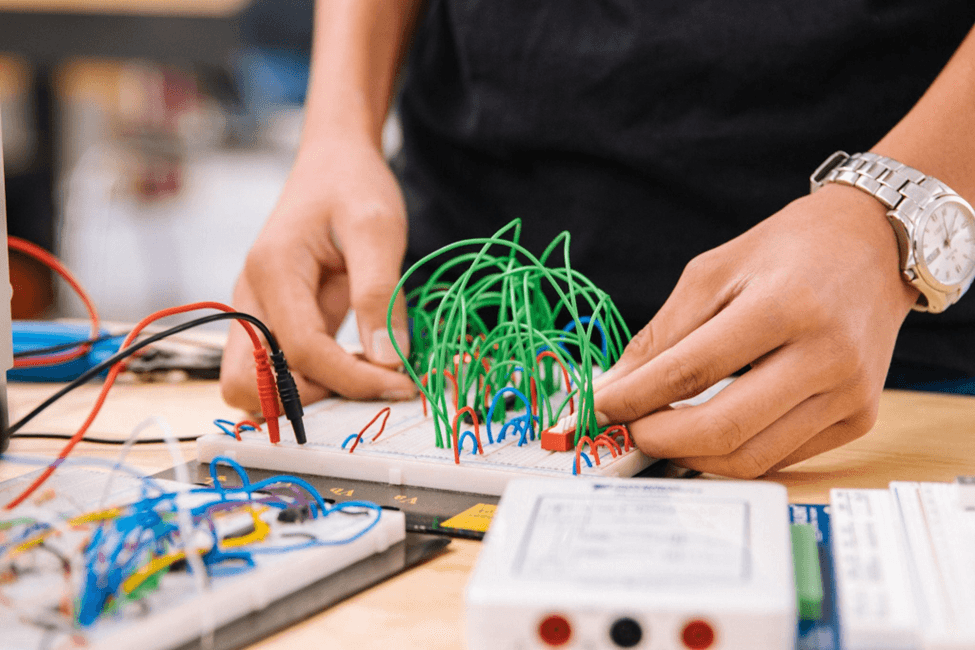By Katie Brenneman

There’s a dearth of good engineers out there. As technology evolves, so does its complexity. Just as important as maintaining the momentum of technological progress is equipping the next generation to pick up where the last one left off.
Part of our obligation today is creating and compiling keystone resources that will aid young engineers in their journey to achieve new breakthroughs. Herein lies the fundamental growth pillars of forward-thinking engineers in various verticals: science, technology, engineering, and mathematics (STEM). Something we must contend with is building up young engineers to be both technically and professionally proficient. Let’s explore a few perspectives and resources that can serve to educate budding engineers and prepare them for the world of tomorrow.
Early STEM Learning Through Play
The Hechinger Report classifies four different styles of play that can promote the early development of a child with a potential for engineering:
- Pretend play - this stretches the innovative brain cells in a child, allowing them to open their mind to new ideas, an essential trait for an engineer to have.
- Exploratory play - this type of play helps children understand constructs and principles, such as solving a puzzle, allowing them to take something apart and attempt to reassemble it.
- Guided play - this incorporates parental involvement, giving the child the opportunity to share in the play, which can prepare them for working with a teammate or assistant.
- Free play - this is the counterpart to guided play, where you give them the freedom to choose how they play and what they play with, which emphasizes independent thinking.
It stands to reason that the early brain development of a child can pave the pathway for their abilities as an engineer. Giving them a diverse selection of modes of play will help round out their cognitive abilities.
Artificial Intelligence in STEM Learning
It’s important to realize the new expectations of tools that new generations of engineers will have at their disposal. This includes artificial intelligence in computers.
Traditional methods of testing and research required manual data input, repetition of the process, and interpretation of results. Now, research AI is expanding the capabilities of engineers, speeding up experiments, and harnessing large swaths of test data automatically.
Research AI uses machine learning to detect patterns in tests and perform its own predictive analyses, which is helpful for a few reasons. For one, this kind of revolution is a huge boon for engineers today since it cuts back on time normally devoted to research and testing. It eliminates the likelihood of human error, ensuring that tests are cleaner and more trustable. And along with saving time, it can also perform testing at far greater speeds than a human could.
The Future of Engineering Consulting and Networking
New mediums are entering the scene that is making remote work more applicable to engineers. Technology like the metaverse is allowing not only consumers to utilize virtual reality to explore storefronts and make transactions but it’s also allowing engineers, technicians, and the like to test and demo machinery.
Distance engineering is a very new thing, but by leveraging VR technology, engineers can transport themselves virtually to a digital rendering of their own experiments or the site of whatever project they happen to be contributing to.
Coupled with this will be the option for much more remote engineering work, and that comes with its own implications. Budding engineers are going to have to maintain an online network to find opportunities.
Much of traditional engineering work relies on physical presence, but when that type of work can be either physical or digital, it suggests that more engineers will work from their own homes or remote offices. Knowing how to build a network online will be (and already is) an important detail in building an engineer’s presence and professional network.
STEM Resources and Tools
Online technical resources, such as the Magnet Schools Assistance Program, can be the perfect starting ground for a budding engineer. Some investigation should go into knowing the student’s preferences and what general topics they enjoy the most and begin from there. Also, look into what classes might be available in the local area or school system.
Adjacent to engineering is the handy skill of web coding and development. The beauty of today’s age is that there are plenty of free online web coding courses where kids can establish their roots in coding.
Young engineers can also access open-source circuit simulators to explore and hone their skills with power electronics applications, systems, and tools. These kinds of skills learned early can prepare them for tangible projects and output later on in their career.
Build Better and Brighter Minds
Again, it’s our duty as the parents and engineers of today to set up the next generation for their own successful future. By teaching them at a young age about the tools they can use to excel, they’ll be able to race up to speed to where we’ve already reached, and beyond.
It’s worth mentioning that while there are significantly fewer female engineers in different verticals today, it shouldn’t deter brilliant, young female minds from pursuing their potential in engineering fields. Learning tools are more accessible than ever, and young girls who are just starting to discover what they like should be given the freedom to explore the world of engineering!
So long as we pay attention to the behavior and inclinations of children when they’re young, we can identify their areas of strength and get them on the right path early.
Want to learn more about STEM?
Check our K-12 and Higher Education catalogs to learn more


